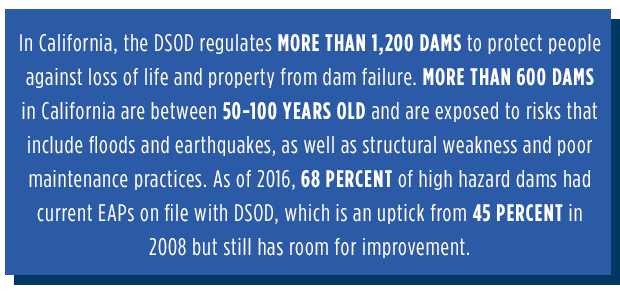Emergencies in California seem to hit the news all the time, from wildfires, droughts and mudslides to earthquakes and floods. One of the more dramatic events in recent history was the disaster in February 2017 at the Oroville Dam in Northern California. During the crisis, emergency evacuation was delayed because the inundation map and Emergency Action Plan (EAP) on file did not address the potential failure of the emergency spillway. The Oroville Dam spillway failure has exposed the need for updated emergency preparation across the state and elsewhere in the country.
On June 27, 2017, in response to the Oroville Dam crisis, California Gov. Jerry Brown signed SB 92 into law, implementing new requirements focused on dam safety. SB 92 provides the Department of Water Resources (DWR) with enforcement tools, including fines and operational restrictions for failure to comply. Prior to SB 92, the state did not have any authority to require dam owners to develop EAPs.
EAPs are critical components of safety programs for dams that must be submitted through a formal process for each state. An EAP is essentially a blueprint for emergency response following a dam-related incident, and it outlines various failure scenarios and response procedures. In California, dam owners must submit EAPs to the California Governor’s Office of Emergency Services (Cal OES) for approval by deadlines that are based on the dam’s downstream hazard classification. Regulations now are based solely on the dam’s downstream hazard classification. Any dam classified as “extremely high hazard,” “high hazard” and “significant hazard” will be required to submit updated EAPs. Extremely high hazard dams were required to submit their updates by Jan. 1, 2018. High hazard dams are required to have updated EAPs (with appropriate inundation maps) submitted by Jan. 1, 2019, and significant hazard dams are required to file the update by Jan. 1, 2021.

SB 92 mandates the following changes:
- Maps and technical supporting studies now must be reviewed by the California Division of Safety of Dams (DSOD). Previously, Cal OES performed the only review.
- Inundation maps are now a prerequisite for submitting an update to an EAP. The inundation map review timeframe can be a sticking point for jurisdictions that need to meet a deadline. DSOD regulates more than 1,200 dams. Review timeframes can take one to three months because of the sheer number of updates coming in to the agency for review. Furthermore, debris basins that were previously exempt are now subject to dam inundation mapping requirements. SB 92 mandated that inundation maps be made public, which was not previously required.
EAPs are now required to contain several elements, including but not limited to: inundation maps; chain of command notification flowcharts and contact information; response procedures; roles and responsibilities for dam owners and impacted jurisdictions; preparedness activities and schedules; methods to update regularly; and any additional information that may impact life or property.
Local public safety agencies and departments may adopt and incorporate emergency procedures for the evacuation and control of affected areas into local hazard mitigation plans. EAPs must be updated every 10 years or when significant downstream changes occur. Once Cal OES approves an EAP, dam owners must conduct notification exercises with a local public safety agency.
DWR has the authority to impose fees and penalties for noncompliance and to change fees charged to dam owners for state supervision related to dam safety.
Addressing these types of disaster planning efforts can seem overwhelming. However, the new requirements will ultimately help municipalities better prepare for the moment disaster strikes. Having experienced consultants on hand to address the new regulations will be an asset to dam owners and people living and working near dams.
Severe weather conditions and natural disasters led to unprecedented damages in 2017 in the U.S. A watershed-based mindset, integrated approach, smart-tech tactics and appropriate planning set the stage for vital solutions.

